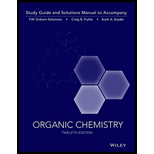
Concept explainers
Interpretation:
The major product resulting from each of the given competition experiments is to be predicted.
Concept introduction:
Nucleophilic substitution happens by two different mechanisms:
The
In the rate determining step, leaving group generates a carbocation intermediate.
Carbocation intermediated then undergoes a rapid reaction with nucleophile.
The
In the rate determining step, nucleophilic approaches the carbon from the side directly opposite to the leaving group.
The
Want to see the full answer?
Check out a sample textbook solution
Chapter 6 Solutions
Organic Chemistry, 12e Study Guide/Student Solutions Manual
- Would heating each of the following reactions increase the yield of the product shown? (a) (b) NAOH Br Nao CIarrow_forwardOct-1-yne (HC≡CCH2CH2CH2CH2CH2CH3) reacts rapidty with NaH, forming a gas that bubbles out of the reaction mixture, as one product. Oct-1-yne also reacts rapidty with CH3MgBr, and a different gas is produced. Write balanced equations for both reactions and identify the gases formed.arrow_forwardWhich of the reaction conditions could afford the following transformation?arrow_forward
- 4) Provide the arrow-pushing mechanism for the following reactions. (3 pts) a) b) CH3OH Br + HCI DMF Brarrow_forwardUsing your reaction roadmap as a guide, show how to convert ethylene into 1-butene. All of the carbon atoms of the target molecule must be derived from ethylene. Show all intermediate molecules synthesized along the way.arrow_forwardAlcohols are important for organic synthesis, especially in situations involving alkenes. The alcohol might be the desired product, or the OH group might be transformed into another functional group via halogenation, oxidation, or perhaps conversion to a sulfonic ester derivative. Formation of an alcohol from an alkene is particularly powerful because conditions can be chosen to produce either the Markovnikov or non-Markovnikov product from an unsymmetrical alkene. Using your reaction roadmap as a guide, show how to convert 4-methyl-1-pentene into 5-methylhexanenitrile. You must use 4-methyl-1-pentene and sodium cyanide as the source of all carbon atoms in the target molecule. Show all reagents needed and all molecules synthesized along the way.arrow_forward
- (a) Tsomane and Nyiko were given a task of synthesising methylenecyclohexane 2. After a brief discussion with each other, Tsomane proposed Method A to synthesise 2 from cyclohexanone 1 while Nyiko proposed Method B that started from hydroxymethylcyclohexane 3. Each student believed that their proposed method is better than the other. (Scheme below) (1) 1 Ph THF A Ph Ph B H₂SO4 100 °C 3 OH What is the name of the reaction that is followed by reaction Method A?arrow_forward1) Provide the reagent(s) and the reaction mechanism of the following reaction. H₂Narrow_forwardCompound D, shown below, reacts with hydrogen bromide by electrophilic addition. A mixture of two organic compounds, E and F, is formed. CH3 CH₂CH₂ CH3 H compound D HBr Mixture of organic compounds E and F (i) Name the the two organic compounds E and F and show their condensed formula. (ii) Briefly explain the mechanism of the reaction between compound D and hydrogen bromide to form either compound E or compound F. (You can list/state the main steps) (iii) Which compound, E or F is the major product?arrow_forward
- The reaction of 1-bromopropane and sodium hydroxide in ethanol occurs by an SN2mechanism. What happens to the rate of this reaction under the following conditions?(a) The concentration of NaOH is doubled.(b) The concentrations of both NaOH and 1-bromopropane are doubled.(c) The volume of the solution in which the reaction is carried out is doubled.arrow_forwardThe following two sets of reactions, ((a) and (b)), show possibilities for arrow pushing in individual reaction steps. Identify which is wrong and explain why. Next, using the correct arrow pushing, label which molecule is the nucleophile and which is the electrophile. (a) (b) H3C :Cl: H3C H,c-i: – →: I-CH3 + :Cl: C-C: H3C / H3C H3C-Cl: C-CH3 H3C : H,C-Cl: H3C-CI: →: I-CH3 + :Cl: H3C :Cl: H3C C-CH3 C-CI: H3C/ H3C H3Carrow_forwardAnswer the following questions regarding the nucleophilic substitution reaction shown below: CH3CH2CH2-Br + I- ------> CH3CH2CH2I + Br- (a) Write the rate law for this reaction assuming that it is a one step reaction that is first order in each of the reactants. (b) Holding the concentration of the iodide ion constant, what change would be observed in the rate if the concentration of the n- propyl bromide was tripled? (b) Assume that this is an exothermic reaction, draw the energy profile and identify the location of the transition state. (c) Draw the transition state for this reaction. (d) What change is observed for the entropy of the system during this reaction? (e) Show the likely mechanism of this reaction using the proper curved arrowsarrow_forward

 Organic ChemistryChemistryISBN:9781305580350Author:William H. Brown, Brent L. Iverson, Eric Anslyn, Christopher S. FootePublisher:Cengage Learning
Organic ChemistryChemistryISBN:9781305580350Author:William H. Brown, Brent L. Iverson, Eric Anslyn, Christopher S. FootePublisher:Cengage Learning

